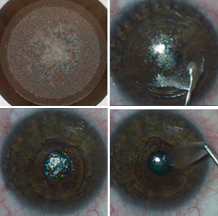 |
| Lasik patients could be subjected to a higher risk of corneal nerve damage than those who undergo SMILE. Photo: Bobby Saenz, OD, Anthony Vanrachack, OD, and Alexandra Wiechmann, OD. Click image to enlarge. |
In an effort to compare postoperative corneal sub-basal nerve density and number between small-incision lenticule extraction (SMILE) and femtosecond laser-assisted in situ keratomileusis (LASIK), researchers recently found the corneal nerve injury in LASIK to be worse than that in SMILE, which had a better corneal nerve recovery at three months post-op. However, there was no significant difference in corneal nerve density or number between the two groups at six months postoperatively.
The investigators conducted a search through PubMed, EMBASE and the Cochrane library for prospective comparative studies. The analysis was divided into two parts: network meta-analysis and traditional meta-analysis of the studies directly comparing two surgical groups. Twelve studies (n=775) were included.
In the network meta-analysis, the SMILE group showed a significant increase compared with the LASIK group in corneal nerve density at one month postoperatively and in the number of corneal nerve trunks at six months postoperatively. In the traditional meta-analysis, the SMILE group showed significant improvement compared with the LASIK group in corneal nerve density at one and three months postoperatively and in the number of corneal nerve trunks and corneal nerve branches at one month postoperatively.
“The results suggest that the degree of corneal nerve damage in the SMILE group is lower than that in the FS-LASIK group immediately postoperatively,” the study authors concluded in their paper, published in Journal of Refractive Surgery.
Jiang X, Wang Y, Yuan H, et al. Influences of SMILE and FS-LASIK on corneal sub-basal nerves: a systematic review and network meta-analysis. J Refract Surg. April 1, 2022. [Epub ahead of print]. |

